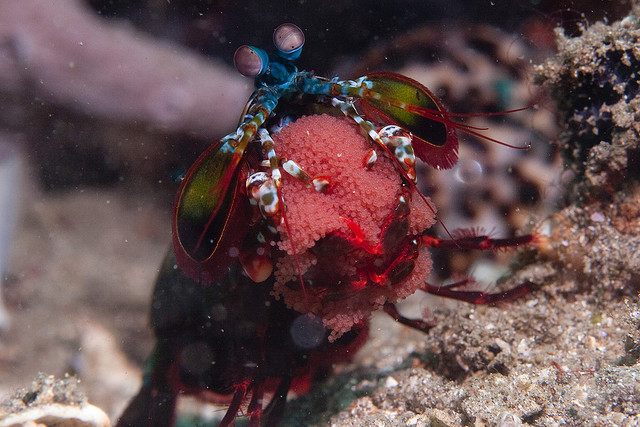KidZone Animals
Mantis Shrimp
The mantis shrimp is one of the most interesting crustaceans found in the ocean. Scientists study their strength, molecular structure and eyesight because it's all so unusual -- they are super-shrimp!
Strength:
In the case of the mantis shrimp, being called a shrimp isn't an insult -- they are swift, tough and effective death machines of the sea!
Mantis shrimp are only about four inches long but pound for pound are one of the strongest animals in the world. They use clubs that are more like elbows than fists to punch their prey -- with the force of a bullet shot from a 22 caliber gun. This incredible force is important for hunting food -- easily breaking the shells of prey like crabs and clams.
When captured, scientists keep mantis shrimp in strong plastic tanks because their punch could break a glass tank.
The clubs of the shrimp are spring loaded -- similar to a crossbow -- when they release their club, it accelerates at over 50 miles per hour with a force of over 330 pounds -- up to 2500 times the shrimp's own weight. If something the size of a person could hit that hard, they could break steel.
 In
order to punch that hard without breaking their clubs, mantis shrimp
have a special shock absorbent core that has a molecular structure
different than any other animal we know of -- this structure is called a
bouligand structure. The bouligand structure keeps small cracks
from becoming a full break. This allows the shrimp to punch
repeatedly without ever breaking -- they may have many micro-cracks but
never a break.
In
order to punch that hard without breaking their clubs, mantis shrimp
have a special shock absorbent core that has a molecular structure
different than any other animal we know of -- this structure is called a
bouligand structure. The bouligand structure keeps small cracks
from becoming a full break. This allows the shrimp to punch
repeatedly without ever breaking -- they may have many micro-cracks but
never a break.
Researchers are mimicing the bouligand structure of the mantis shrimp to design thin, light materials strong enough to stop explosives and build stronger frames for things like cars.
Speed:
But they aren't just strong, they're fast too! They have the fastest predatory strike in the ocean -- swinging in less than 800 microseconds. In the time it takes you to blink an eye, the mantis shrimp could theoretically punch 500 times.
If you could throw a baseball as fast as the mantis shrimp punches, you'd launch the ball into space!
Because the mantis shrimp is so fast, its punch results in something scientists call cavitation -- a super heated bubble that results in a small flash of light. Between the punch and the heat, the mantis shrimp's prey doesn't stand a chance!
Sight:
The mantis shrimp uses it's amazing sight to see prey -- they have the broadest visual spectrum of any animal we know of. Scientists are studying the mantis shrimp eyes in an attempt to build small cameras that can see cancer cells at very early stages.
Like a lobster, the mantis shrimp's eyes are on stalks that the shrimp can move around -- they can even move their eyes in different directions. To imagine the stalks, think of having stubby arms with eyeballs on the ends -- you could swing them left or right, forward or back to see things in all different directions. Very cool!

Mantis Shrimp guarding its eggs - both the male and
female do depending on the species.
photo by Buzz, CC BY-NC 2.0
Romance:
Some mantis shrimp species mate for life -- they meet the shrimp of their dreams and they share the same burrow, protect their eggs and help each other with hunting for their entire lives -- up to 20 years.
More Information about Mantis Shrimp:
There are about 400 different species of mantis shrimp (the peacock mantis shrimp is my favorite). Most have clubs like the ones discussed though some have "spears" instead -- the theory is the same, but instead of smashing their prey, the shrimp with spears skewer their prey instead -- still with great strength and speed.
Mantis shrimp are aggressive animals who find a home burrow and don't venture away from it very much, except occasionally when hunting food or outside factors force them to move. Although they do go out hunting sometimes, they prefer to ambush prey that comes near their burrows.
They live around the world in shallow, sub-tropical and tropical marine environments.
Scientific stuff: Arthropods include eleven animal classes
Kingdom: Animalia
Phylum: Arthropoda
Subphylum: Crustacea
Class: Malacostraca
Subclass:
Hoplocarida
Order: Stomatopoda


